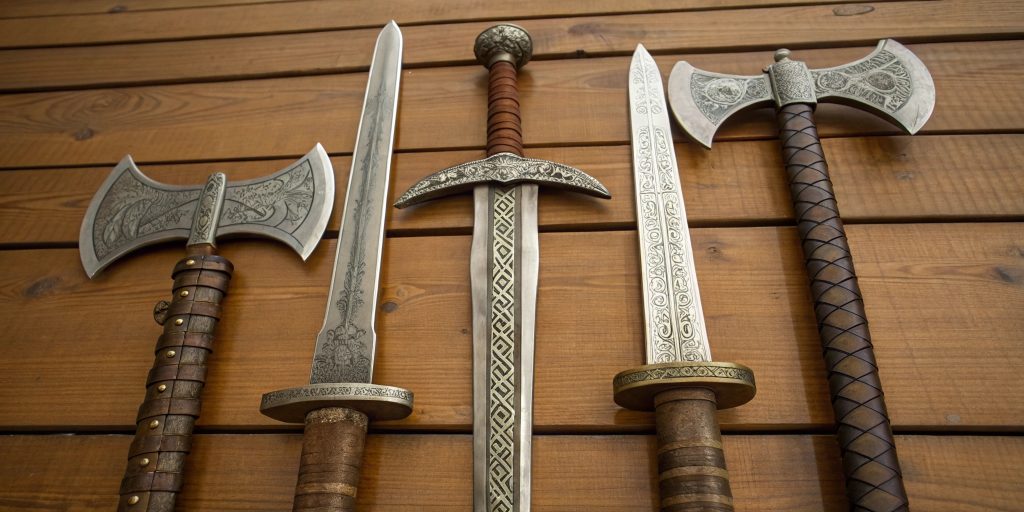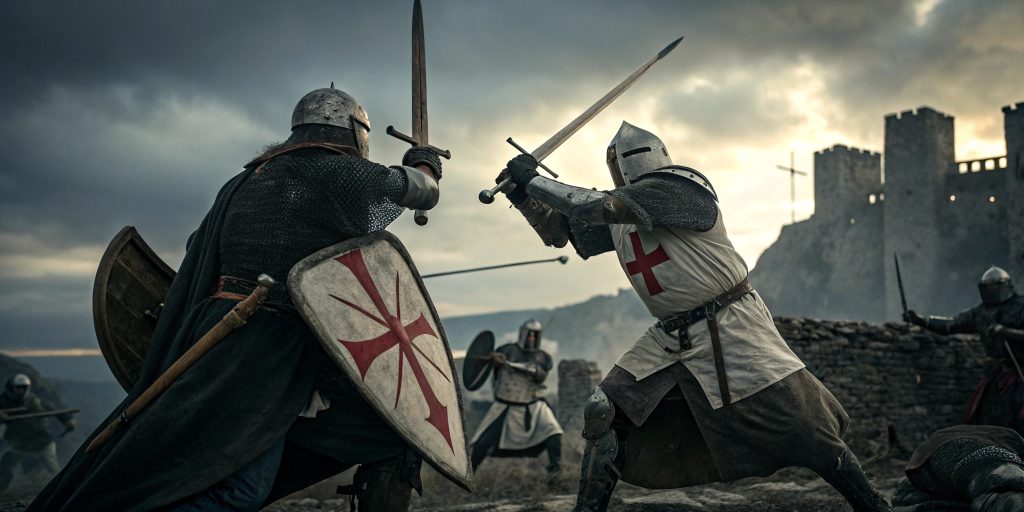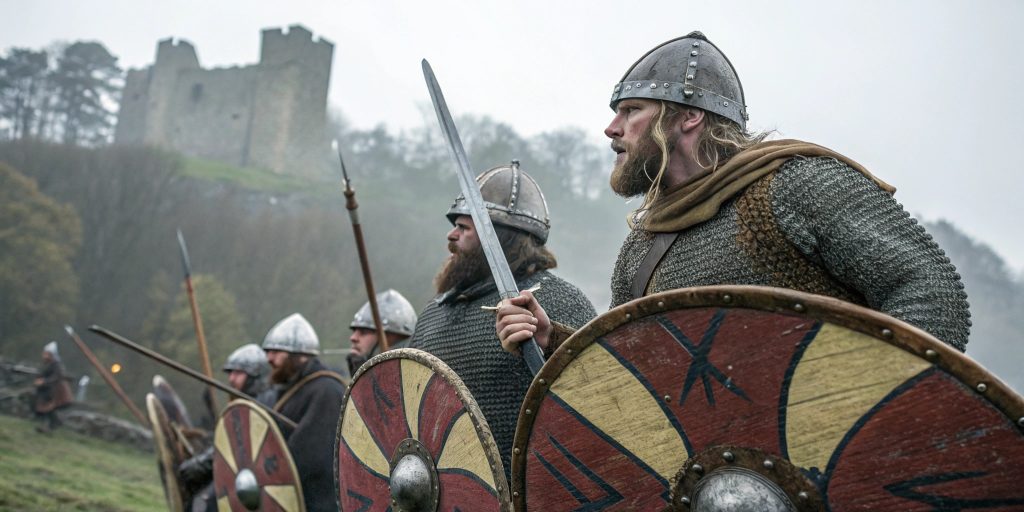The study of Anglo-Saxons weaponry gives us a peek into early medieval warriors’ strategies. It shows how their tools and tactics might have helped the Templar Knights during the Crusades. This article examines how Anglo-Saxon weapons and warfare evolved and how their methods could have shaped the Templar Knights’ holy missions.
By studying these two groups, we gain historical insights and see the importance of their weapons in organized warfare.
Introduction to Anglo-Saxons Weaponry
The Anglo-Saxon period was filled with unique weapons. These tools were not just for fighting. They also showed the culture and identity of the people. Swords, including the Anglo-Saxon swords, shields, and axes, were vital, playing big roles in society.
Weapons were more than just for war. They showed a warrior’s status and skill. The making of these weapons was a mix of art and function. They were deadly in battle and symbols of power.
Battles’ changing over time show the impact of invaders like the Vikings. Their battles led to new weapons and tactics. This mix of conflict and creativity made Anglo-Saxon weapons a key part of history.
The Evolution of Anglo-Saxon Weapons and Warfare
The evolution of weapons in the Anglo-Saxon period, including the bow and arrow, is a key part of their warfare history. It shows how simple tools like the pommel turned into advanced arms over time, helping shape many battles.
At first, warriors used bronze tools. However, as iron became more common, weapons improved, leading to advancements in early Anglo-Saxon armaments. This change made battles more effective.
In the early medieval period, military tactics changed greatly due to Viking and Norman influences. Anglo-Saxon leaders started using new strategies to fight back.
Places like Sutton Hoo show these changes in weapons and fighting styles. Archaeologists found evidence of new tactics and tools, such as the sling, in Anglo-Saxon graves.
- The transition from individual combat to organized army formations
- Influence of Viking and Norman military practices
- Archaeological evidence supporting changes in weapon design has been found in Anglo-Saxon England.
As time passed, the Anglo-Saxon military, influenced by the lessons 1066, improved. They focused on making weapons like the arrowhead and tactics work together. These changes are seen in the big battles of the Anglo-Saxon era. They show how warriors adapted to new challenges.
Key Weapons of the Anglo-Saxon Warriors
Anglo-Saxon warriors were skilled in using various weapons. This skill shaped their battle strategies, especially in the context of the Battle of Hastings. The Anglo-Saxons swords and axes were key to their success.

Types of Swords Used
The swords used by Anglo-Saxons varied in design. They showed both function and artistry. The broad sword had a double-edged blade for quick slashes.
These iron swords, with their robust hilt and pommel, were durable. The seax, a shorter single-edged blade common in Anglo-Saxon life, was used daily. It was easy to carry and popular among warriors.
Importance of the Anglo-Saxon Axe
The Anglo-Saxon axe was crucial in close combat. Its wide, sharp blade could deliver powerful blows and was used to fight against heavy armor.
The axe was not just a weapon but also a symbol of strength. It was often shown in historical art like the Bayeux Tapestry. Warriors with axes were depicted, showing their preference for this weapon.
The use of swords and axes showed the Anglo-Saxons’ adaptability and resourcefulness. They had a well-rounded approach to warfare.
Armor and Shields of the Anglo-Saxons

Anglo-Saxon warriors had to be tough to survive battles. They used armor and shields to protect themselves. The round shield was vital, especially in the shield wall tactic.
Design and Functionality of the Anglo-Saxon Shield
The Anglo-Saxon shield was round and made of wood with metal on the rim. It was good at blocking attacks and easy to move around, making it ideal for an archer.
- Shape: The round shape helped protect the whole body in battle.
- Materials: Shields were light and made of wood for quick movements.
- Decoration: Shields showed off personal or family symbols, showing status and identity.
Types of Helmets Worn by Anglo-Saxon Warriors
Helmets were key for head protection in battle. There were many types, each showing status and origin.
- Conical Helmets: These had pointed tops and were made of iron for basic protection.
- Decorated Helmets: Some helmets had fancy designs showing rank and status.
- Face Guards: Some helmets had faceguards for extra safety in fights.
The shields and helmets helped warriors, including archers, fight better. They could face tough battles with more confidence.
Combat Techniques in Anglo-Saxon Warfare
Anglo-Saxon warriors used many combat techniques to win battles. The shield wall was key to their success. It gave protection and a strong front line in war.
This method helped soldiers work together well. It also helped them deal with the chaos of close combat.
Understanding the Shield Wall
The shield wall was a main part of Anglo-Saxon fighting. Warriors stood close together, their shields locked, creating a strong barrier against enemies.
This setup had many benefits:
- It helped warriors stand strong against enemy attacks.
- It made it hard for enemies to break through the line.
- It allowed commanders to change plans easily, adapting their strategies with various weapons used during the Anglo-Saxon era.
Anglo-Saxon warriors were also skilled in hand-to-hand combat. They used swords, axes, and the bow and arrow to fight face-to-face. They moved quickly to find weak spots in their foes.
The place where battles took place was also important. In open fields, the shield wall worked well. But in woods or uneven ground, they changed their plans to use the land to their advantage. This showed how good they were at fighting in different places, a skill common in Anglo-Saxon warfare.
Templar Knights and Their Weaponry
The Templar Knights, influenced by the practices of the later Anglo-Saxon period, started in the 12th century. They were formed to protect pilgrims going to the Holy Land. They were not just monks; they were skilled soldiers with advanced weapons.

They had many types of historical arms, including those found in Anglo-Saxon graves:
- Swords: They used the arming sword, which is good for slashing and thrusting, and other weapons used in battle.
- Lances: Lances helped them fight on horseback against enemies during the Crusades.
- Crossbows: Crossbows let them attack from far away, a new tactic in medieval warfare.
Templar weapons were different from Anglo-Saxon ones. Anglo-Saxons often used swords and axes, while Templars had a wider range of weapons, showing their ability to adapt to different battles.
Their monastic background shaped their war tactics. They were disciplined, strategic, and organized, making them a strong force in the Crusades.
Learning about Templar weapons gives us a deeper look into medieval warfare. Their arms were key to their victories and helped shape battle strategies of the time.
Lessons from Anglo-Saxons for the Templar Knights
The Templar Knights were known for their battle skills. They could learn a lot from the Anglo-Saxons’ use of weapons and tactics, which could help them fight better in historical battles.
The Anglo-Saxons used a shield wall tactic, which gave them protection and a solid front line. The Templar Knights could learn from this to strengthen their ranks and maintain their discipline in battles.
The Anglo-Saxons had many weapons, such as swords, axes, and spears. Each had its role in battle. The Templar Knights could use this variety to be more flexible in combat, which was vital when facing different enemies in the Crusades.
By studying these Anglo-Saxon lessons, the Templar Knights could improve their battle strategies, making them more effective in war.
Contemporary Relevance of Anglo-Saxon Weaponry
Anglo-Saxon weapons are still important in martial arts, historical reenactments, and study. They teach us about combat sports, self-defense, and the effective use of javelins, which were crucial in early Anglo-Saxon warfare. Many martial arts use old fighting techniques, showing their value.
During historical reenactments, people show their skills with swords, axes, and shields. They aim to be true to the past, showing how these tools were made and used. These events teach us about old warfare and honor history.
Scholars study old weapons to learn about military history. They see how old tactics, such as those employed by the Saxons, are still used today. This helps military leaders learn from the past to solve conflicts better.
- Understanding weapon designs of the past, such as those used by the Saxons, enhances modern craftsmanship.
- Martial arts benefit from techniques rooted in historical fighting styles.
- Reenactments provide practical demonstrations of the Anglo-Saxon combat ethos.
- The study of weapons and armor influences contemporary military thought and tactics.
Summary
Anglo-Saxon weapons, including the spearhead, were vital in shaping military tactics. They also set the stage for future warriors, like the Templar Knights. These weapons and strategies evolved, affecting warfare up to the Crusades.
The design of swords, axes, and shields shows the innovation of Anglo-Saxon weapons. These tools were vital in battles, and learning from them gives us lessons that are still useful today.
Looking at ancient military practices and modern strategies helps us understand warfare and culture. By studying the past, we see the lasting impact of Anglo-Saxon weapons on today’s military thinking.

